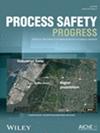采用 HAZOP、FMECA、监测算法和贝叶斯网络综合方法进行详尽的风险评估和实时安全分析:案例研究
IF 1
4区 工程技术
Q4 ENGINEERING, CHEMICAL
引用次数: 0
摘要
危险研究对于石化行业确保安全操作至关重要。本文深入分析了真空蒸馏装置熔炉的相关危险。该研究旨在确定与熔炉操作相关的可能危险情况,评估相关风险,并提供预防和缓解策略。为实现这些目标,我们采用了一种综合策略,结合了两种分析方法:危险可操作性分析 (HAZOP) 和故障模式、影响和临界分析 (FMECA)。通过这种综合方法,可以进行全面的风险评估,并采取适当的预防措施,以保持安全运行,包括翻新工程。然后,根据这两种方法的结果,考虑到熔炉效率、管道温度和烟气温度等参数,对设备安全进行持续评估是非常重要的。因此,我们用 Python 创建了一个监控程序,可以通过这些关键参数对熔炉的安全性进行实时检查。如果安全条件受到影响,就会发出警报以降低风险,尤其是在发生故障时。此外,还开发了一个贝叶斯模型来评估算法结果,并确定改造和故障情况。这种全面的方法提高了风险评估的可靠性和精确性,确保了安全高效的工业运行。本文章由计算机程序翻译,如有差异,请以英文原文为准。
HAZOP, FMECA, monitoring algorithm, and Bayesian network integrated approach for an exhaustive risk assessment and real‐time safety analysis: Case study
Hazard studies are essential in the petrochemical industry to ensure safe operations. This article provides an in‐depth analysis of the hazards associated with a vacuum distillation unit furnace. This study aims to identify probable hazard scenarios related to furnace operation, assess the associated risks, and provide prevention and mitigation strategies. A comprehensive strategy was employed to achieve these objectives, combining two analysis methods: HAZard OPerability (HAZOP) and Failure Modes, Effects, and Criticality Analysis (FMECA). This integrated approach enables a comprehensive risk assessment to be carried out and appropriate preventive measures to be taken to maintain safe operations, including renovation work. Then, depending on the results of the two methods, it is essential to constantly evaluate equipment safety, taking into account parameters such as furnace efficiency, tube temperature, and fume temperature. Therefore, a monitoring program has been created in Python, which enables real‐time examination of the furnace's safety with these critical parameters. If safety conditions are compromised, alarms are sent to mitigate risks, particularly in case of a failure. A Bayesian model is also developed to evaluate the algorithm's results and determine renovation and failure case scenarios. This comprehensive approach improves risk assessment's reliability, precision, maintains safe and efficient industrial operations.
求助全文
通过发布文献求助,成功后即可免费获取论文全文。
去求助
来源期刊

Process Safety Progress
工程技术-工程:化工
CiteScore
2.20
自引率
10.00%
发文量
99
审稿时长
6-12 weeks
期刊介绍:
Process Safety Progress covers process safety for engineering professionals. It addresses such topics as incident investigations/case histories, hazardous chemicals management, hazardous leaks prevention, risk assessment, process hazards evaluation, industrial hygiene, fire and explosion analysis, preventive maintenance, vapor cloud dispersion, and regulatory compliance, training, education, and other areas in process safety and loss prevention, including emerging concerns like plant and/or process security. Papers from the annual Loss Prevention Symposium and other AIChE safety conferences are automatically considered for publication, but unsolicited papers, particularly those addressing process safety issues in emerging technologies and industries are encouraged and evaluated equally.
 求助内容:
求助内容: 应助结果提醒方式:
应助结果提醒方式:


